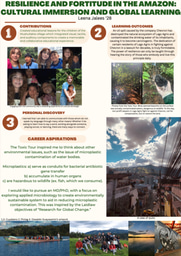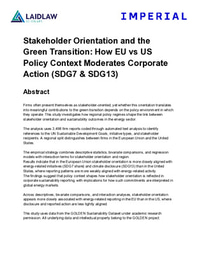Project Outline: Lessons from Uruguay’s Hydropower Network under Drought
The 2022-23 drought in Uruguay and its devastation of the nation’s drinking water supply was covered widely in international media. Paso Severino Reservoir, Uruguay’s primary drinking water source, was depleted to under 2% capacity, depriving much of the population of safe tap water and causing massive agricultural losses. Around a third of Uruguay’s electricity is generated domestically using hydroelectric dams, which were also majorly impacted by the drought. My research will evaluate the extent of the drought’s effect on Uruguayan hydropower, assess the vulnerabilities in their energy supply, and examine broader domestic and transnational ramifications of a disrupted energy system.
As the climate crisis worsens, extreme conditions increasingly threaten vital infrastructure, including hydropower systems. With the global proliferation of renewable energy and specifically hydroelectricity, Uruguay’s drought crisis serves as a pertinent case study on the impacts of climate-related disruptions to these systems. Uruguay’s relatively small network of four dams can provide insight into how more complex systems could be affected. Hydroelectric projects in other river basins, particularly the transboundary Nile River and Mekong River Basins, are increasingly causing interstate tensions over water and energy resources. Knowledge of how hydroelectric systems are impacted by the growing climate crisis is instrumental to understanding associated geopolitical challenges, not only in Uruguay but globally.
I will begin the project by collecting data on Uruguay’s four hydroelectric dams. Using USGS topography data and satellite imagery from NASA’s Landsat program, I will gather biweekly data on water storage levels in each dam’s reservoir before, during, and after the drought. My faculty advisor Professor Stefano Galelli has created the InfeRes package, capable of generating this storage data from available geospatial sources. Due to the nature of this model and required adjustments, this will require approximately two weeks of full-time work.
Using the gathered data, I will analyze the drought’s impact on hydropower production. Through correlation analysis of the evaluated storage levels and publicly available weather data, I will distinguish the effects of the drought from normal variation in reservoir storage. I will then evaluate the impact of altered water reserves on hydropower production from each dam, and connect these findings to measure the drought’s overall impact on output from the entire network. This will take around two weeks.
My project will then explore the unique vulnerabilities of Uruguay’s hydropower network. Studying localized weather and hydrological conditions at the Paso Severino drinking water reservoir will allow me to determine the factors leading to its depletion. Because the dam is not part of a larger network, I can isolate specific external factors unaffected by changes in other dams. Then, I will investigate whether the four hydroelectric dams share or differ in their vulnerabilities to extreme climate conditions, assessing the circumstances which could affect these dams to the extent of Paso Severino. By analyzing the four dams in detail, I can identify changes to Uruguay’s hydroelectric system that will improve its resiliency. This will take about one week.
Finally, my project will explore the wider implications of Uruguay’s drought-affected energy system. While the drinking water crisis visibly led to major protests and unrest, the effects of the energy situation were seemingly more subtle. Prior to the drought, Uruguay generated excess electricity which it sold to its neighbors, but reduced power generation during the drought led Uruguay to instead buy energy from neighboring Brazil and Argentina. My project will explore the consequences of the drought on Uruguay’s relations with its neighbors and on overall regional dynamics. Correlating changes in hydropower output to data on electricity prices, economic output, or international trade, for example, will provide insight into the role of a resilient energy supply. Studying crossborder implications of the nation’s drought-induced energy crisis will reveal possible geopolitical risks that could result from a similar scenario in a more volatile region of the world. This will take around one week.
Because the climate crisis is still developing, many of its consequences remain understudied. As nations increasingly turn to renewable energy, understanding the pitfalls of new technology is essential to building a sustainable world. Studying the effects of the 2022-2023 drought on Uruguay’s hydropower network will contribute both to a greater understanding of the crisis in Uruguay and to an overall insight into the global role of energy systems in a changing climate.





Please sign in
If you are a registered user on Laidlaw Scholars Network, please sign in